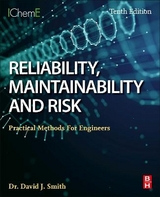
Reliability, Maintainability and Risk
Butterworth-Heinemann Ltd (Verlag)
978-0-08-102010-4 (ISBN)
- Titel erscheint in neuer Auflage
- Artikel merken
For beginners, the book provides tactics on how to avoid pitfalls in this complex and wide field. For experts in the field, well-described, realistic, and illustrative examples and case studies add new insight and assistance. The author uses his 40 years of experience to create a comprehensive and detailed guide to the field, also providing an excellent description of reliability and risk computation concepts.
The book is organized into five parts. Part One covers reliability parameters and costs traces the history of reliability and safety technology, presenting a cost-effective approach to quality, reliability, and safety. Part Two deals with the interpretation of failure rates, while Part Three focuses on the prediction of reliability and risk.
Part Four discusses design and assurance techniques, review and testing techniques, reliability growth modeling, field data collection and feedback, predicting and demonstrating repair times, quantified reliability maintenance, and systematic failures, while Part 5 deals with legal, management and safety issues, such as project management, product liability, and safety legislation.
Dr. David J. Smith is the Proprietor of Technis Consultancy. He has written numerous books on Reliability and Safety over the last 40 years. His FARADIP database has become widely used, and his other software packages are also used throughout the profession. His PhD thesis was on the subject of reliability prediction and common cause failure. He contributed to the first drafting of IEC 61508 and chairs the IGEM panel which produces SR/15 (the gas industry safety related guidance). David is past President of the Safety and Reliability Society.
Part 1: Understanding Reliability Parameters and Costs 1. The History of Reliability and Safety Technology 2. Understanding Terms and Jargon 3. A Cost-Effective Approach to Quality, Reliability and Safety
Part 2: Interpreting Failure Rates 4. Realistic Failure Rates and Prediction Confidence 5. Interpreting Data and Demonstrating Reliability 6. Variable Failure Rates and Probability Plotting
Part 3: Predicting Reliability and Risk 7. Basic Reliability Prediction Theory 8. Methods of Modeling 9. Quantifying the Reliability Models 10. Risk Assessment (QRA)
Part 4: Achieving Reliability and Maintainability 11. Design and Assurance Techniques 12. Design Review, Test and Reliability Growth 13. Field Data Collection and Feedback 14. Factors Influencing Down Time 15. Predicting and Demonstrating Repair Times 16. Quantified Reliability Centered Maintenance 17. Systematic Failures, Especially Software
Part 5: Legal, Management and Safety Considerations 18. Project Management and Competence 19. Contract Clauses and Their Pitfalls 20. Product Liability and Safety Legislation 21. Major Incident Legislation 22. Integrity of Safety-Related Systems 23. A Case Study: The Datamet Project 24. A Case Study: Gas Detection System 25. A Case Study: Pressure Control System 26. Helicopter Incidents and Risk Assessment
Appendix 1: Glossary Appendix 2: Percentage Points of the Chi-Square Distribution Appendix 3: Microelectronic Failure Rates Appendix 4: General Failure Rates Appendix 5: Failure Mode Percentages Appendix 6: Human Error Probabilities Appendix 7: Fatality Rates Appendix 8: Answers to Exercises Appendix 9: Bibliography Appendix 10: Scoring Criteria for BETAPLUS Common Cause Model Appendix 11: Example of HAZOP Appendix 12: HAZID Checklist Appendix 13: Markov Analysis of Redundant Systems Appendix 14: Calculating the GDF
| Erscheinungsdatum | 31.03.2017 |
|---|---|
| Verlagsort | Oxford |
| Sprache | englisch |
| Maße | 191 x 235 mm |
| Gewicht | 990 g |
| Themenwelt | Technik ► Elektrotechnik / Energietechnik |
| Technik ► Maschinenbau | |
| ISBN-10 | 0-08-102010-4 / 0081020104 |
| ISBN-13 | 978-0-08-102010-4 / 9780081020104 |
| Zustand | Neuware |
| Haben Sie eine Frage zum Produkt? |
aus dem Bereich



